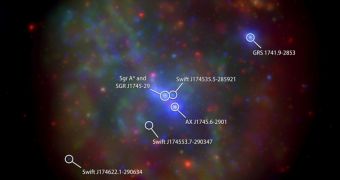Astronomers operating the NASA Swift Gamma-Ray Burst Mission satellite announce the discovery of a new subclass of neutron stars at the core of the Milky Way. The finding was made possible by a long-term study of X-ray activity in the central regions of our galaxy, predominately in the areas around Sagittarius A*, the supermassive black hole powering up the core.
Swift has been imaging the central regions of the galaxy in X-rays for around 7 years, as part of a long-term effort to understand how the Milky Way behaves at these wavelengths. The research has already doubled the amount of images available to astronomers from all other missions combined.
In addition to obtaining an in-depth view of how events such as X-ray flares occur, the team was also able to discover a type of neutron star that might help them test the tenets of Albert Einstein's theory of general relativity. This theory has been undergoing checks and double checks for decades.
Details of the Swift study were presented by mission scientists on Wednesday, January 8, at the 223rd annual meeting of the American Astronomical Society (AAS), held in Washington, DC. The team said that the new data would enable experts to gain a deeper insight into the physical nature of X-ray flares.
Sagittarius A* is known for producing large volumes of X-ray flares, and Swift was able to image a large number of them during its investigations. The supermassive black hole is located some 26,000 light-years away, in the direction of the constellation of Sagittarius. Estimates places its mass at 4 million times that of the Sun.
“Given its size, this supermassive black hole is about a billion times fainter than it could be. Though it's sedate now, it was quite active in the past and still regularly produces brief X-ray flares today.” explained the principal investigator of the galactic center survey campaign, Nathalie Degenaar.
The expert holds an appointment as an astronomer with the University of Michigan in Ann Arbor. Experts from the Pennsylvania State University, the DOE Los Alamos National Laboratory in New Mexico, and Orbital Sciences Corp. are also a part of the Swift team. International partners include organizations from Germany, Japan, Italy and the United Kingdom.
Degenaar said that the satellite first began investigating Sagittarius A* in February 2006. Since then, Swift has been taking 17-minute-exposure images of the Milky Way core every few days, contributing to the creation of a massive database.
Over this time frame, the telescope was able to identify 6 extremely-bright X-ray flares, where Sagittarius A* became up to 150 times brighter than usual at these wavelengths. Similar flares may occur once every 5 to 10 days, indicating that the black hole may be going through some sort of cycle.
Degenaar added that 2014 would be a critically-important year for the mission, since Swift would get a chance to analyze how the black hole rips apart a massive gas cloud called G2, which is roughly three times heavier than Earth. Sagittarius A* will rip it apart and eat it via tidal and gravitational forces.
It is entirely possible that Q2 2014 will see G2 pulled with such force that gas molecules within the cloud create significant amounts of friction, enough to heat the entire structure up to the point where it begins releasing X-rays. If any gas passes the black hole's event horizon, Sagittarius A* may light up too.
“Astronomers around the world are eagerly awaiting the first sign that this interaction has begun. With the invaluable help of Swift, our monitoring program may well provide that indicator,” explained Pennsylvania State University astronomer and Swift science team member, Jamie Kennea.
While scanning for signs of G2's motions in April 2013, astrophysicists discovered a very powerful and high-energy X-ray burst, which originated at a location very near to the central black hole in the galaxy. Analysis of the data revealed that the emissions were produced by a very rare subclass of a neutron star,
According to Swift, the object in question is a magnetar, a subtype of neutron star that exhibits extremely powerful magnetic fields. These objects release vast volumes of X-ray and radio radiations. This particular celestial orb is called SGR J1745-29 and, like all other neutron stars, was produced by a massive supernova explosion.
The object – one of only 26 ever discovered – is so dense that it packs about 500,000 Earth masses in sphere with a diameter smaller than that of Washington DC. Astrophysicists now hope to use it to test predictions about Albert Einstein's theory of general relativity, by analyzing how its pulses are emitted as the object orbits Sagittarius A*.
“This long-term program has reaped many scientific rewards, and due to a combination of the spacecraft's flexibility and the sensitivity of its [X-ray telescope], Swift is the only satellite that can carry out such a campaign,” said the principal investigator of the Swift mission, Neil Gehrels. He holds an appointment with the NASA Goddard Space Flight Center, in Greenbelt, Maryland.

 14 DAY TRIAL //
14 DAY TRIAL //